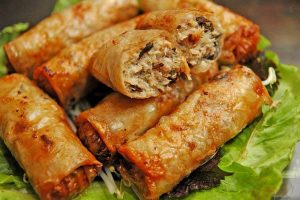Fried Spring Rolls
Travelling to Vietnam, one of the most delicious dishes can be widely seen in all of restaurants or even at food stalls of street vendors, that is Nem Ran. It is called as Fried Spring Roll in English. Vietnamese spring rolls are delicious and crispy exterior and flavorful filling. This dish is a must in any traditional Vietnamese banquets or celebration parties. Vietnamese spring rolls are the perfect combination of many ingredients that are mixed together. They are originally made from ground pork, shrimp, carrot, egg, mushroom, vermicelli and shredded veggies. It is then wrapped with rice paper and fried till golden and crispy. When all is well done, Vietnamese fried spring rolls are served with fresh noodle, fresh mixed vegetable including of lettuce, mint leaves, purple leaves, corianders dipping in fish sauce.

How to make spring rolls?
It is not too difficult to make it but there are some basic steps you should keep in mind as below:
- Prepare all of fresh ingredients
- Put the prepared filling into dry rice paper and roll it up.
- Fry in the frying pan with low heat till being well done.
How to make the dipping sauce?
The sauce is really important for this dish as it seems to be the spirit of its. Actually it is not too easy but too difficult to make sauce for fried spring roll. There are many ways to make the sauce but the simple one everyone can do is to boil water, when it is boiling, add sugar in it. You make sure that the amount of sugar you add is not too much or less. Then stir it around till the sugar is completely melting. Let’s wait till the water cool down, then add some rice vinegar and and fine fish sauce at last. Stir it all and it is ready to taste. You can add ground pepper, chopped garlic and fresh chillies into the sauce to get more flavorable.
- ←
-
Email Us
Please send us an Email
